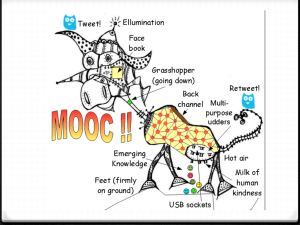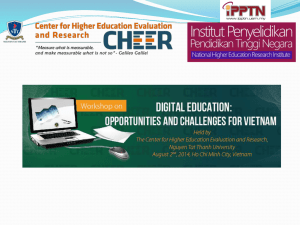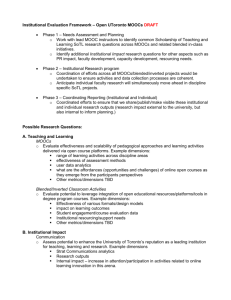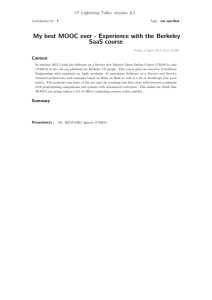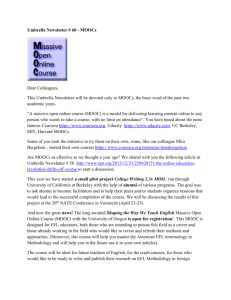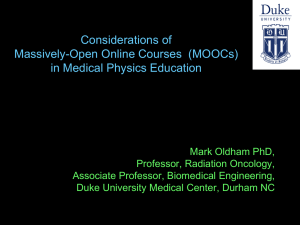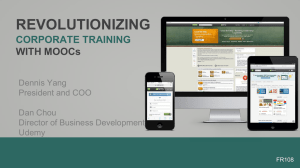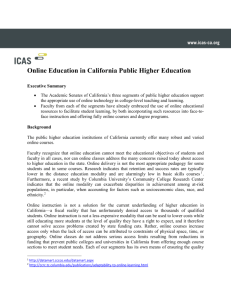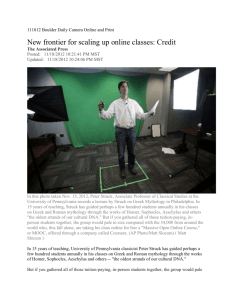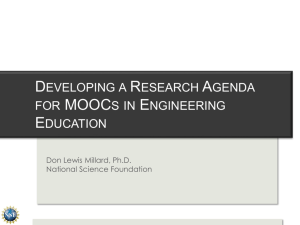What is a MOOC?
advertisement
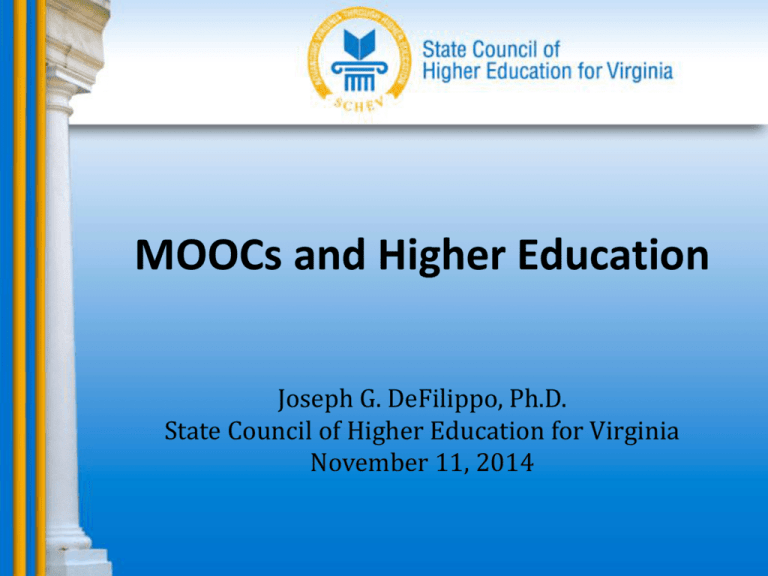
MOOCs and Higher Education Joseph G. DeFilippo, Ph.D. State Council of Higher Education for Virginia November 11, 2014 What is a MOOC? Massive Open Online Course 2 Massive… • Introduction to Artificial Intelligence, P. Norvig and S. Thrun, Stanford, fall 2011: 160,000. • “Six-figure enrolments are atypical, with the median average enrolment being 42,844 students, and decreasing over time as the number of courses available continues to increase” (K. Jordan, cited at http://techcrunch.com/2014/03/03/study-massiveonline-courses-enroll-an-average-of-43000-students-10-completion/) 3 Open… • Open access, rather than open content. – Offered by elite institutions, but are available without admissions requirements. – Cost-free (sort of) to the student, but content is (in many cases) proprietary. • Contrast: Open Education Resources (OER) 4 Online… • Internet (i.e., not correspondence, not synchronous broadcasting) • Components – Video: broken down to discrete segments – Feedback: to check comprehension and progress – P2P Learning: student forums (sometimes wiki-like knowledge integration) 5 Course. • Content organization and sequencing of presentation is analogous to a traditional college course; there’s a beginning and end. – But not identical: • • • • Credit generation Relation to degree program Role of instructor E.g., Khan Academy (topic breakdowns 6 MOOC Providers http://www.moocs.co/Higher_Education_MOOCs.html Carnegie Mellon University – Open Learning Initiative Class2Go Coursera EDRAAK edX Enaco EWANT Fort Hays State University FUN: France Universite Numerique France's National MOOC platform FUTURELEARN, INC. Holland College IFP School iMooX Institute des Mines-Telecom INSTRUCTURE / Canvas Network Iversity LUXVERA MIRIADAx MITx MOOC.org MOOC FACTORY MOOCs University MOOEC MR UNIVERSITY Najah National University NationsUniversity North Carolina State University OERu OpenCourseWorld OpenHPI OpenLearn OPENLEARNING OPEN2STUDY OpenUpEd Phoenix College Rwaq Stanford University Salford Business School Sunstone Business School Swinburne University of Technology Tsinghua University UDACITY UNEOPEN UNESP aberta UniMOOC Universidade Aberta – iMOOC UNEDCOMA Universidad Politecnica de Madrid Universitat Polytecnica de Valencia (UPVX) University of Amsterdam University of California - Irvine: OpenCourseware University of the People University of Western Australia UNx Veduca World Science University Yale Open Courses 7 “Business” Booming (https://www.edsurge.com/n/2013-12-22-moocs-in-2013-breaking-down-the-numbers) 8 MOOC Hype? 9 MOOC Skepticism • • • • • Digitized Textbooks ATM for lectures and texts Marketing for elite institutions Low completion (6.8%) Failed online ventures 10 MOOC Skepticism— The San Jose State Incident In spite of our admiration for your ability to lecture in such an engaging way to such a large audience we believe that having a scholar teach and engage with his or her own students is far superior to having those students watch a video of another scholar engaging his or her students. --San Jose State Philosophers The worry that the widespread use of online courses will damage departments in public universities facing budgetary pressures is a legitimate concern that deserves serious debate, at edX and throughout higher education. The last thing I want is for my online lectures to be used to undermine faculty colleagues at other institutions. --Michael Sandel, Harvard 11 Real MOOC Challenges • Quality (educational, not institutional) – Learning requires more than watching videos and taking multiple choice tests. – But, MOOC-related research is revealing new information about how people become engaged by learning and how they retain what they’ve learned. • E.g., attention span, data-mining from student preferences and questions. 12 Real MOOC Challenges • Certification/Credentialing – MOOCS—most of them, for now—do not actually convey college credit – New forms of assessment and credentials are arising. • “badges,” “specializations” • major organizations developing credit-granting schemes for some MOOCS (ACE/Coursera) 13 Real MOOC Challenges • Long-term financial viability – “It’s a money loser. MOOCs are enormously expensive to produce, and they make zero money. This is the kind of business model only bankrupt corporations could love.” Prof. Larry Sabato, The Cavalier Daily, August 31, 2013 – But what is the business model? 14 Coursera, for example • Founded 2012 (Stanford roots) • October 2014: – 105 partner institutions, 839 courses offered, 10 million users • April 2012-November 2013: $85M in venture funding • Signature Track: – $49 per course. [43,000 x .068 x $49 = $143,276] • New Thing: Specializations. – Targeted sequence of courses, followed by a capstone project. Pay $49 per course. – Johns Hopkins Data Science Specialization: 9 courses/39 weeks/ $421 15 Coursera Specialization Certificate In the future, something will be viable • Amazon • What’s the potential scale? – All-time most-viewed Youtube clips 1. Gangnam Style—Psy. 2,126,047,035 2. Baby—Justin Bieber w/ Ludacris. 1,106,296, 681 3. Charlie bit my finger again—Harry & Charlie Davies-Carr. 794,310,365 4. On the Floor—Jennifer Lopez w/ Pitbull. 789,638,623 5. Party Rock Anthem. LMFAO w/ Lauren Bennett & Goonrock—766,411,024 17 The importance of openness • MOOCs are just one phenomenon in the realm of innovative uses of instructional technology. • Open Education Resources – E.g., Tidewater Community College “Z-degree.” Potential for $3000 savings in two years worth of full-time study. – At request of Secretary Fornash, SCHEV worked with institutions to form OpenVA, to help propagate increased utilization of quality open resources. 18 All human beings naturally desire knowledge. --Aristotle Information wants to be free. --Stewart Brand
